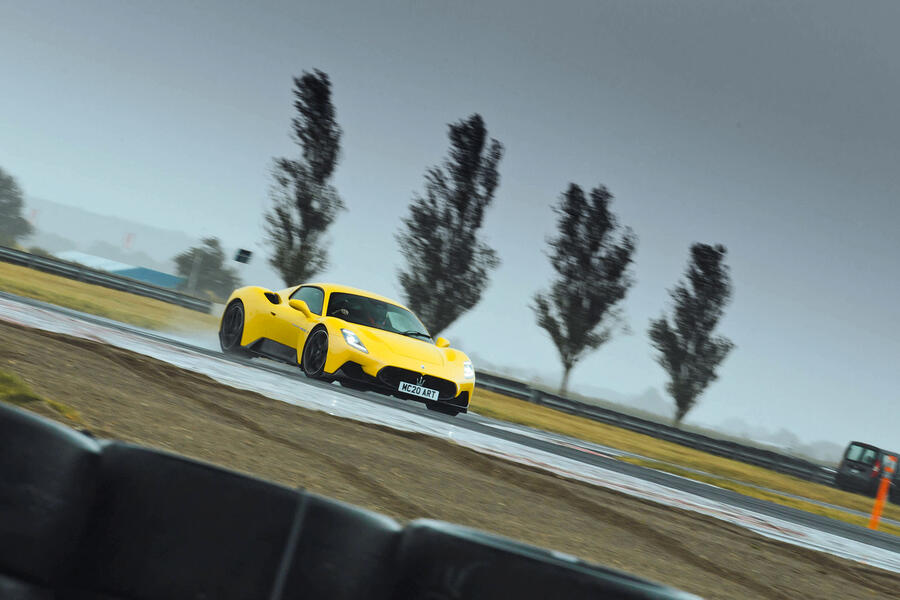This post was originally published on Autocar
Scullion’s training session took part on Bedford Autodrome’s 1.87-mile West Circuit
With a 621bhp Maserati and a greasy Bedford Autodrome, we find out how to become a track day champion
Like most people attending their first session of track driving tuition, I have fallen at the first hurdle. Well, not so much the first hurdle. This is more like not doing up my laces properly.
Driving position, vision, braking. These three fundamentals are at the forefront of what I learn at Bedford Autodrome on a slightly wet and greasy Tuesday. And it is the driving position where I let myself down.
“Typically, most men tend to sit far too far back,” Christian Vann tells me. Vann is PalmerSport’s chief instructor, a former Le Mans racer and a very patient man.
Being too far back leads to an outstretched leg position, which doesn’t provide optimal power from your quads and hamstrings when braking. Also, in the event of a crash, your leg will go through your pelvis if it’s outstretched. Which, I’m assured, is not ideal.
This might all seem a bit dry considering the pictures in front of you are of a mid-engined Italian supercar. But the fundamentals, the boring stuff, are what make the biggest differences when piloting something like a Maserati MC20 at 200mph.
Now that I can actually sit correctly, I should probably start driving. We’re here to find out how easy it is for a supercar newcomer to extract performance from one on a track, but I warm up in a BMW X3 PHEV on Bedford’s West Circuit.
A few laps of the 1.8-mile 12-corner circuit fly by, and before I know it I’m out in the Maserati. I’m fortunate to have had the car for a couple of days prior to this track session, so I know my way around it.
But I have driven on only a handful of tracks, and I have driven only a handful of supercars, and I have never, ever combined the two.
My first few laps are taken fairly gingerly. But I eventually get into the swing of it. The night before, I casually looked up the track’s layout on my phone (I suspect Lewis Hamilton does the same thing before races), which revealed I’d be tackling the shortest of the four possible configurations.

Despite this, I feel a bit lost at times. Corner 11, the penultimate one, is long, sweeping and so wide.
Four laps sail by and it’s time for some feedback. “There are probably more good points than I was expecting,” says Vann. Damning with faint praise there, but I’ll let him continue.
“Your steering technique was absolutely fine,” he says. “But you need to use a bit more of the width of the track, which will help smoothen out that throttle.”
I couldn’t agree with him more. I did feel lost and I did feel unsmooth. On the drive to Bedford, the MC20 felt like it delivered its power pretty broadly. But on track, with the adrenaline racing through me and the gearchanges coming quickly, I’ve found it all becomes a bit peaky.
Out for round two. Vann’s pep talk has given me a real spring in my step and, with a bit more confidence in me now, I feel much more at home using the track’s full width and I use the accelerator and brakes more gradually and less like an on/off switch.
We come in for a bit of lunch. Vann notes that I have relatively good car control. I look up at social media executive Jonathan Bryce and snapper Jack Harrison, who are with me today. Both pretend they didn’t hear it, but they did.
I finish up some couscous and discover that it is now raining heavily. Damn. We hang around for a while and it calms down. Then we head outside. Vann says a greasy track can be even trickier than a wet one.
He explains the benefit of shifting up early to quell the 538lb ft of turbocharged torque and we take to the track.
His words fail to make much of an impression on my prefrontal cortex as I nail it in second gear and ceremoniously feel the back end snap. I catch it, though having dialled the drive mode back to Sport means the DSC will have helped.
Eventually, it’s time for the final debrief. “Where I thought that you had made the most improvement was in braking, in terms of your initial hit on the brakes – getting the car slowed down,” says Vann.
“The main area for improvement, and I’m sort of getting into some more advanced levels now, is actually how you release the brake pedal.
“It’s one thing going on the brakes and slowing the car down, and that’s kind of obvious, but actually, how you release the brakes plays a big part in the handling of the car.”

Sitting here now at my desk, I can understand the merits of not simply braking as hard as possible. But on-track Murray did not see it like that.
Tedious insurance reasons meant I couldn’t time myself. But Vann reckons I’m around 12 seconds per lap faster after the tuition.
He says improvements can be even larger among people coming from a lower base level. His words, not mine.
The secret to supercar driving? Supercars are just like regular cars.
Sorting the basics – seating position, vision, looking through a corner, braking in a straight line, straightening the steering wheel before applying power – in any car will make a difference. It’s just that there’s more at stake and there are bigger gains to be made in a supercar.

